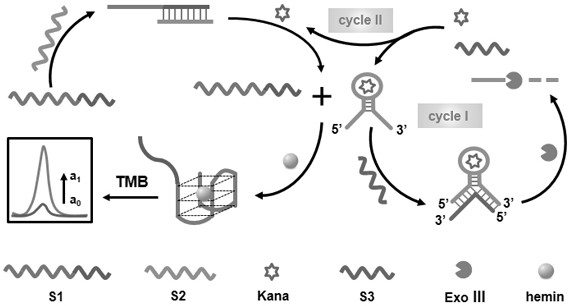A homogeneous biosensing method for detecting kanamycin and its application
A kanamycin and biosensing technology, applied in the field of biological analysis, can solve the problems of poor repeatability, cumbersome operation and high cost, and achieve the effects of high analytical sensitivity, overcoming cumbersome operation and short detection time.
- Summary
- Abstract
- Description
- Claims
- Application Information
AI Technical Summary
Problems solved by technology
Method used
Image
Examples
Embodiment 1
[0018] A homogeneous biosensing method for detecting kanamycin of the present embodiment comprises the following steps:
[0019] (1) G-quadruplex characteristic sequence and kanamycin (Kana) nucleic acid aptamer hybridization double-strand preparation
[0020] Add 990 µL of 10 mM pH=7.4 tris(hydroxymethyl)aminomethane buffer solution to the PV tube, which contains 200 mM NaCl, 10 mM KCl, 1% DMSO and 0.05% Triton X- 100, then add 5 µL 10 µM G-quadruplex DNA strand (S1) and 5 µL 10 µM Kanamycin (Kana) nucleic acid aptamer (S2) solution, the G-quadruplex DNA strand (S1) The base sequence is 5'-GGG TAG GGC GGG TTG GGA ACC TCAAGA CCA CTT GGA CAT TTT-3', and the base sequence in the kanamycin nucleic acid aptamer (S2) is 5'-TGT CCAAGT GGT CTT GAG GTT TTTT-3', shake at room temperature for 45 minutes to obtain aptamer hybrid double-stranded complex solution for use;
[0021] (2) Homogeneous reaction to determine the content of kanamycin in the standard solution
[0022] Take 100 µ...
Embodiment 2
[0025] The detection of kanamycin content in the milk powder sample of embodiment 2
[0026] According to the working curve obtained in Example 1, the content of kanamycin in the milk powder sample was detected. Weigh 1 g of commercially available milk powder and dissolve it in 5 mL of 20 mM pH 7.4 Tris-HCl buffer solution, which contains 100 mM NaCl, 2 mM MgCl 2 and 5mM KCl, take 100µL of the dissolved milk powder solution, add 20% acetic acid to it to adjust the pH to 4.6, centrifuge after 20min to remove the coagulated protein and fat in the sample, and filter the sample with a 0.22μm filter membrane solution, and re-adjust the sample solution to pH = 7.4; take 50 µL of the treated sample solution, add 100 µL aptamer hybridization double-stranded complex solution, 5 µL 2 µM kanamycin nucleic acid aptamer partial complementary sequence ( S3), 5 µL 5U / µL exonuclease III (Exo III) and 5 µL 1 µM hemin (hemin), the base sequence in the partially complementary sequence (S3) of t...
Embodiment 3
[0031] Example 3 Detection of Kanamycin Content in Honey Samples
[0032] According to the working curve obtained in Example 1, the content of kanamycin in the honey sample was detected. Weigh 2 g of commercially available honey and dissolve it in 4 mL of 20 mM pH=7.4 Tris-HCl buffer solution, which contains 100 mM NaCl, 2 mM MgCl 2 and 5mM KCl; then filter the sample solution with a 0.22μm filter membrane; take 50μL of the filtered sample solution, add 100μL aptamer hybridization double-strand complex solution, 5μL 2μM kanamycin nucleic acid aptamer partially complementary sequence (S3), 5 µL 5U / µL exonuclease III (Exo III), and 5 µL 1 µM hemin (hemin), the bases in the partial complementary sequence (S3) of the kanamycin nucleic acid aptamer The sequence is 5'-AAA AAA CCT GAC ACT AC-3'; after vortex mixing at 37°C for 70 minutes, increase the temperature to 65°C, keep it for 5 minutes and then lower it to 25°C; then add 70µL containing 0.4mM TMB, 0.4mM H 2 o 2 The pH=5.0...
PUM
 Login to View More
Login to View More Abstract
Description
Claims
Application Information
 Login to View More
Login to View More - R&D
- Intellectual Property
- Life Sciences
- Materials
- Tech Scout
- Unparalleled Data Quality
- Higher Quality Content
- 60% Fewer Hallucinations
Browse by: Latest US Patents, China's latest patents, Technical Efficacy Thesaurus, Application Domain, Technology Topic, Popular Technical Reports.
© 2025 PatSnap. All rights reserved.Legal|Privacy policy|Modern Slavery Act Transparency Statement|Sitemap|About US| Contact US: help@patsnap.com

